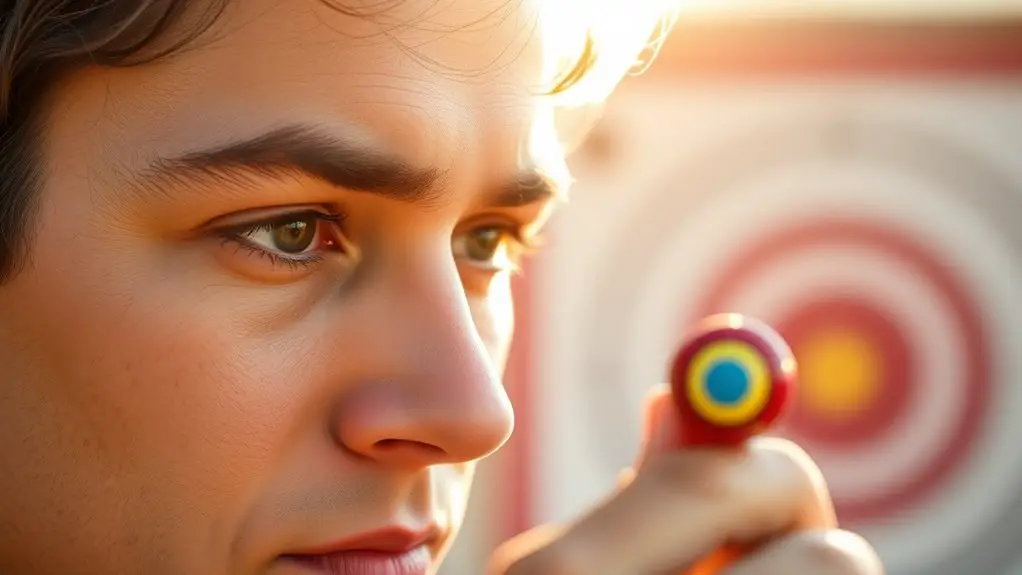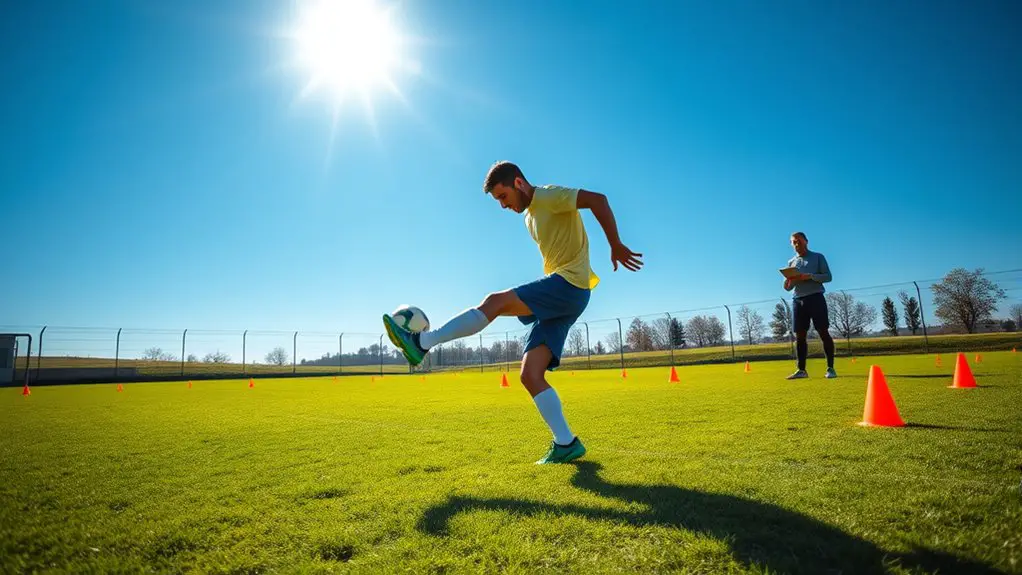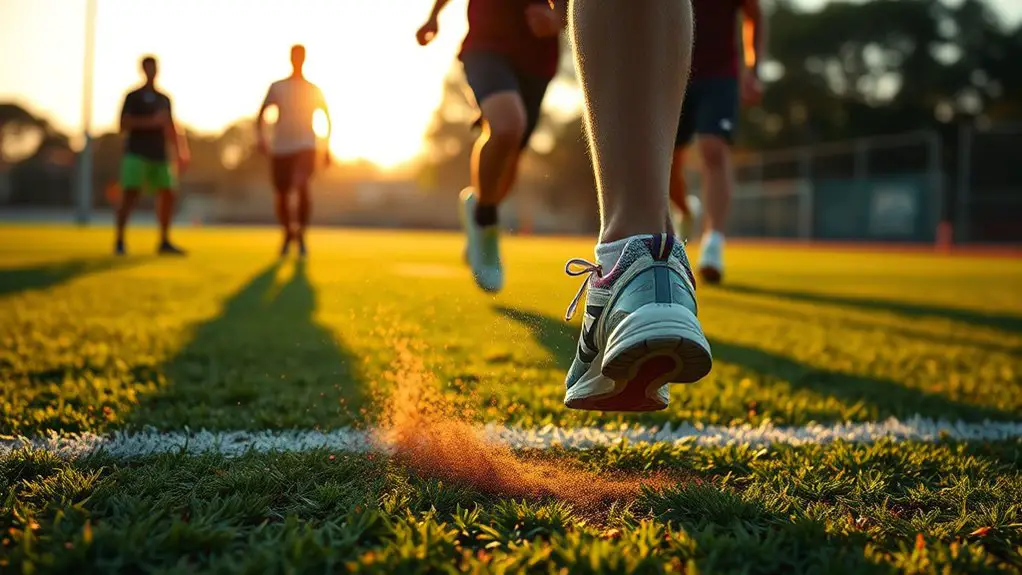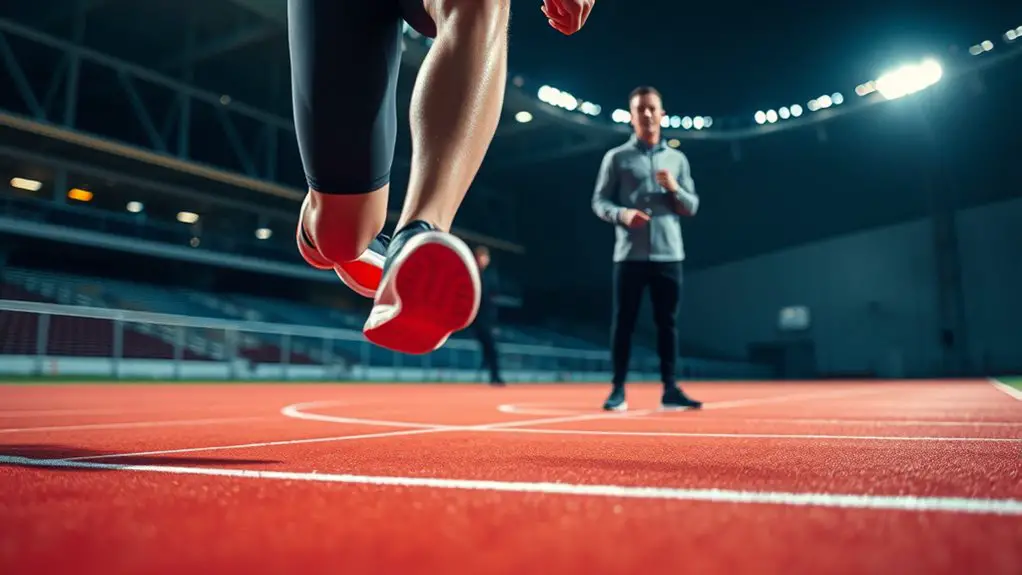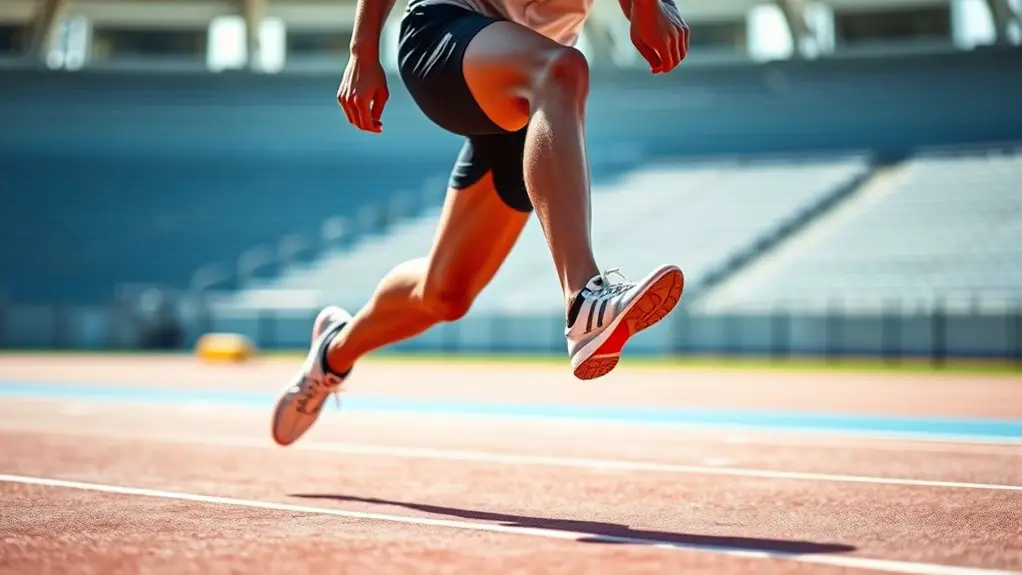To improve your aim, focus on eye coordination exercises like tracking a moving finger and practicing depth perception drills, such as the pencil push. Incorporate peripheral vision training with wall exercises to enhance spatial awareness. Add visualization techniques to mentally prepare before aiming. Don't forget eye relaxation methods for strain relief. Consistently practicing these exercises can greatly enhance your aiming skills and boost overall performance. Discover more effective strategies to further advance your abilities!
Understanding Eye Coordination and Aim
Eye coordination plays an essential role in aim, whether you're shooting a basketball or gaming. Your ability to accurately gauge distance and direction hinges on your binocular vision, which allows both eyes to work together. This teamwork creates depth perception, essential for targeting your shot.
Visual acuity is another key factor. It's about how clearly you see, and sharper vision means better focus on your target. When your eyes are in sync, you're not just seeing the ball or screen; you're connecting with it, feeling that freedom to act confidently.
To enhance your eye coordination, practice exercises that sharpen both your binocular vision and visual acuity. Simple activities, like tracking moving objects or playing catch, can greatly improve your aim. Embrace these exercises, and you'll find yourself hitting those targets with newfound precision, whether on the court or in the virtual world.
The Importance of Focus in Precision
When it comes to precision in your aim, focus is essential. By mastering visual concentration techniques and reducing distractions, you can greatly enhance your performance. Incorporating eye coordination exercises will also help sharpen your accuracy, making each shot count.
Visual Concentration Techniques
Many aspiring marksmen underestimate the role of visual concentration in achieving precision. To truly hit your target, you need to harness visual mindfulness. By focusing your gaze on the target, you can enhance your aim and boost your confidence. Simple techniques, like practicing deep breathing, can help calm your mind and sharpen your focus. This concentration boost allows you to block out distractions, creating a clear mental image of your goal. Additionally, visualizing your shot before taking it can prepare your mind and body to execute with accuracy. Embracing these techniques not only improves your shooting skills but also gives you the freedom to perform under pressure, turning each shot into a confident expression of your abilities.
Reducing Distractions Effectively
To hit your mark consistently, you've got to minimize distractions that can derail your focus. Effective distraction management is key to honing your aim. Here are three strategies to enhance your attention control:
- Create a Dedicated Space: Find a clutter-free zone where you can concentrate fully. This physical separation helps signal your brain to focus.
- Limit Digital Interruptions: Silence notifications on your devices. Set specific times to check messages and emails, keeping distractions at bay during practice.
- Practice Mindfulness: Engage in short mindfulness exercises before aiming. This boosts your ability to stay present and reduces wandering thoughts.
Eye Coordination Exercises
Eye coordination exercises are crucial for improving your aim, as they help sharpen your focus and enhance hand-eye coordination. When you practice visual tracking, you're training your brain to process what your eyes see and react accordingly. This skill is essential for activities that require precision, like sports or gaming, where every split-second decision counts.
Start with simple exercises, like following a moving object with your eyes or alternating focus between near and far targets. As you develop these skills, you'll notice an increase in your ability to gauge distances and react quickly. Embrace these exercises, and you'll find your aim improving, giving you the freedom to perform at your best. Your journey to precision starts with better eye coordination!
Eye Tracking Exercises
Improving your aim can greatly benefit from incorporating eye tracking exercises into your routine. These exercises enhance your tracking accuracy and help you stay focused on moving targets. Here are three effective eye tracking techniques you can try:
Enhance your aim by integrating eye tracking exercises into your routine for improved accuracy and focus on moving targets.
- Follow the Finger: Hold a finger in front of you and move it side to side. Keep your head still and follow the movement with just your eyes.
- Target Shifting: Place two objects a few feet apart. Shift your gaze between them quickly while maintaining focus. This helps improve your ability to track multiple objects.
- Moving Object: Use a ball or a toy car, and move it across your field of vision. Keep your eyes locked on it as it moves, practicing smooth and quick adjustments.
Depth Perception Drills
After honing your eye tracking skills, it's time to focus on depth perception drills. These exercises are essential for enhancing your ability to judge distances accurately, giving you the freedom to aim with confidence. Start with basic depth perception exercises like the "pencil push." Hold a pencil at arm's length, then slowly bring it closer while keeping both eyes open. Notice how the pencil's position shifts against the background.
Another effective drill is the "two-object method." Place two objects at varying distances and alternate your gaze between them. This helps your brain process depth more effectively.
Incorporating visual acuity drills, like focusing on a moving target, can further sharpen your skills. Aim for targets at different distances, challenging yourself to improve. Remember, consistent practice is key to mastering depth perception, allowing you to enhance your aim and performance in any activity you pursue.
Peripheral Vision Training
How often do you think about your peripheral vision when aiming? Enhancing your peripheral awareness can greatly improve your overall aim and performance. By incorporating some simple exercises, you can expand your field of vision and sharpen your focus. Here are three effective techniques to try:
- Focus Shifting: Pick a central point to focus on while keeping your eyes relaxed. Gradually try to notice objects in your peripheral vision without moving your eyes.
- Wall Exercises: Stand in front of a blank wall and without shifting your gaze, try to identify objects or movements in your periphery. This helps with spatial awareness.
- Tracking Movements: Have a friend move an object slowly across your field of vision while you concentrate on a fixed point. This trains your brain to pick up movement outside your direct line of sight.
Embrace these field expansion techniques and watch your aim improve!
Visualization Techniques
While enhancing your peripheral vision helps with spatial awareness, visualization techniques can further refine your aiming skills. These visualization strategies allow you to tap into the power of mental imagery, creating a vivid picture of your desired outcome. Imagine yourself in the moment, focusing on your target with laser-like precision. Picture every detail: the distance, the angle, and the exact point of impact.
To practice, set aside a few minutes each day. Close your eyes and visualize yourself successfully hitting your target. Feel the confidence coursing through you as you accurately aim. Incorporate different scenarios, from varying distances to different lighting conditions, to expand your mental repertoire. Regular practice of visualization techniques can enhance your overall athletic performance and boost confidence in your aiming abilities.
Eye Relaxation Methods
When you're aiming for precision, it's just as important to relax your eyes. Techniques like palming can provide instant relief, while focus shifting exercises help maintain your eye's agility. Let's explore these methods to keep your vision sharp and stress-free.
Palming Technique Benefits
The palming technique is a simple yet effective way to relieve eye strain and promote relaxation. By practicing this method, you can experience several benefits that enhance your overall eye health and well-being. Here are three key advantages:
- Reduces Eye Strain: Covering your eyes helps block out light, allowing your muscles to relax and recover from constant screen exposure.
- Promotes Mental Clarity: Taking a break from visual stimuli can help clear your mind, improving focus and creativity.
- Enhances Blood Circulation: The warmth from your palms stimulates blood flow, nourishing your eyes and reducing fatigue.
Incorporating the palming technique into your routine can provide a revitalizing escape from the pressures of daily life, letting your eyes rest and rejuvenate.
Focus Shifting Exercises
Focus shifting exercises are essential for maintaining eye health, especially in our screen-dominated lives. These exercises enhance your focus flexibility, letting your eyes adapt to different distances effortlessly. Start by holding your finger a few inches from your face, then slowly extend your arm while keeping your focus on it. Next, switch your gaze to a distant object, allowing your eyes to adjust. This target adjustment helps reduce eye strain and improves your aim. Repeat this process several times a day, and you'll notice how much clearer your vision becomes. Incorporating focus shifting into your routine not only relaxes your eyes but also liberates them from the confines of constant screen time, giving you the freedom to see clearly and aim accurately.
Incorporating Eye Exercises Into Your Routine
Although it might seem challenging to fit eye exercises into your busy schedule, incorporating them can greatly enhance your aim and overall eye health. Here's how you can seamlessly weave these practices into your daily routine:
- Morning Stretch: Start your day with a quick five-minute eye care routine. Focus on shifting your gaze from near to far, which primes your eyes for the day ahead.
- Break Time Blinks: Whenever you take a break from screens, do a few eye exercises. Simply look away and focus on distant objects. This helps reduce strain and improves focus.
- Evening Wind Down: Before bed, dedicate a few minutes to relax your eyes. Try palming or gentle eye rolls to release any tension built up during the day.
Measuring Progress and Results
Tracking your progress with eye exercises can be as straightforward as keeping a journal. Jot down the exercises you do, how long you practice, and any noticeable changes in your aim. This simple act of progress tracking not only keeps you motivated but also helps you identify patterns over time.
After a few weeks, review your results. Are you hitting targets more consistently? Can you focus on fast-moving objects better? By regularly evaluating your performance, you can tailor your routine to maximize your gains. Don't hesitate to tweak your exercises based on what feels right for you—freedom in your practice encourages growth.
Frequently Asked Questions
Can Eye Exercises Improve My Performance in Sports?
Can eye exercises really transform your sports performance? You might be surprised. These simple routines can enhance your visual coordination and boost your focus training, giving you an edge on the field or court. Imagine the freedom of moving with precision, anticipating every play. It's not just about strength or speed; your eyes play an essential role. So, why not give these exercises a shot and see how they can elevate your game?
How Long Should I Practice Eye Exercises Each Day?
When it comes to practicing eye exercises, it's best to incorporate them into your daily routine. Aim for about 10 to 15 minutes each day; this way, you'll see steady improvement without feeling overwhelmed. You can break it down into shorter sessions if that fits your lifestyle better. Remember, consistency is key, and finding a practice duration that feels right for you will make it easier to stick with it long-term.
Are There Specific Exercises for Different Sports?
If you want to access the superhuman abilities of your eyes, you've got to immerse yourself in targeted exercises for specific sports! Different activities require different visual skills, so customizing your routine is key. For instance, tennis players might focus on tracking fast-moving objects, while basketball players benefit from depth perception drills. By tailoring your exercises, you'll not only enhance your aim but also embrace the freedom to elevate your game like never before!
Can Eye Exercises Help With Vision Problems?
Absolutely, eye exercises can play a significant role in vision therapy, especially for those facing vision problems. If you're struggling with eye health issues, targeted exercises can help strengthen your eye muscles and improve focus. They can enhance coordination and clarity, giving you more freedom in your daily activities. By incorporating these exercises into your routine, you might notice improvements that empower you to see the world with greater ease and confidence.
Is There an Age Limit for Doing Eye Exercises?
Absolutely, age isn't a barrier for eye exercises! Whether you're a youthful enthusiast seeking benefits or a senior looking for adaptations, there's something for everyone. These exercises can enhance vision at any stage of life, promoting freedom and functionality. You'll find that adapting routines to fit your age can make a significant difference. So, why not embrace the opportunity? Age is just a number when it comes to nurturing your eye health!
